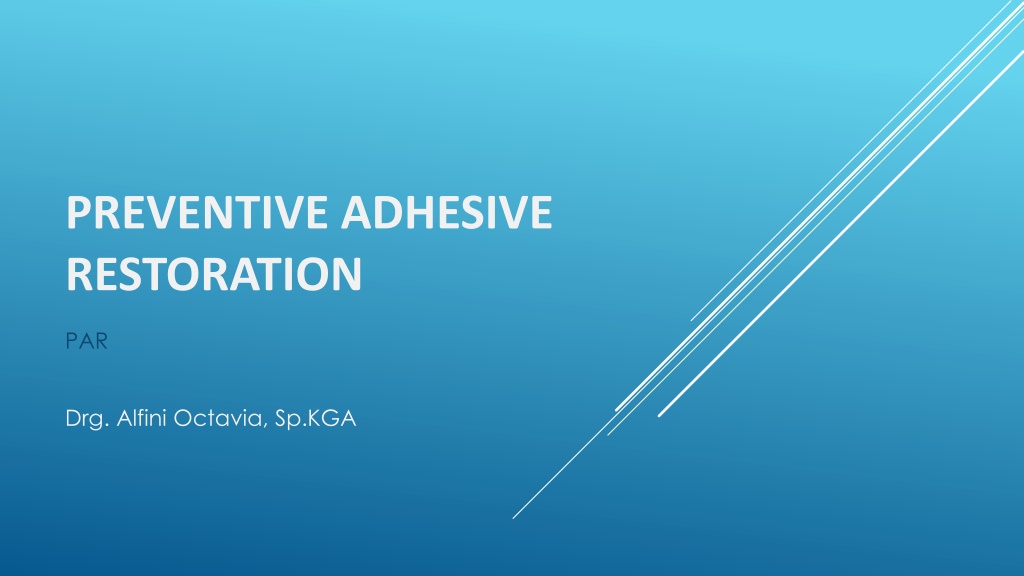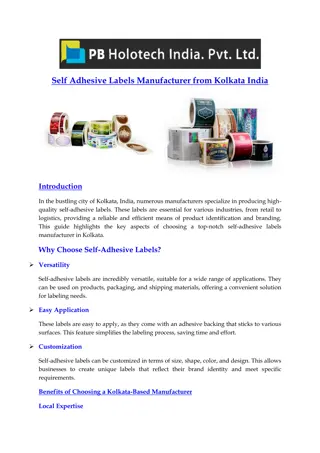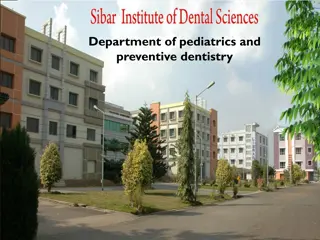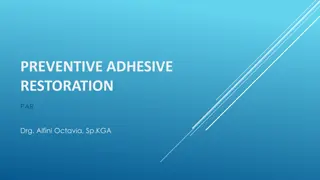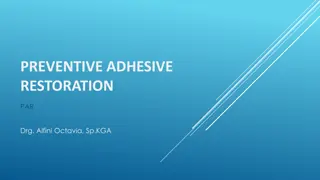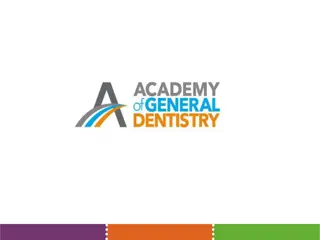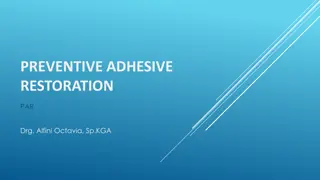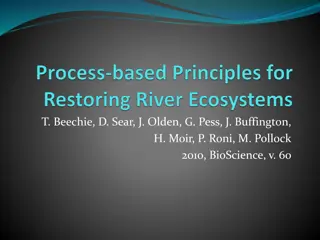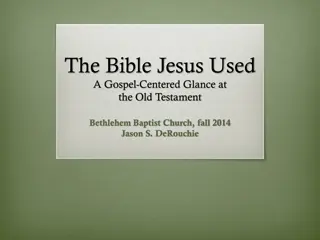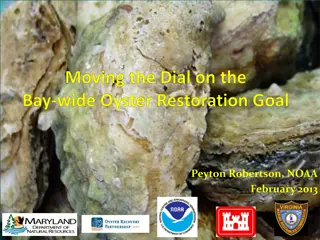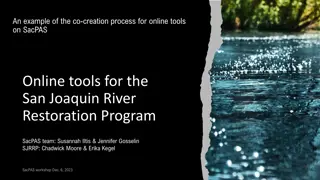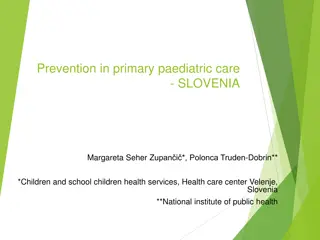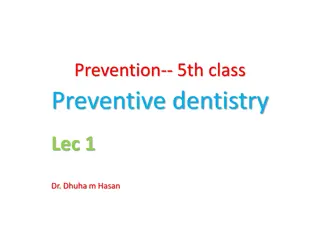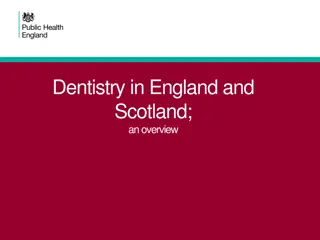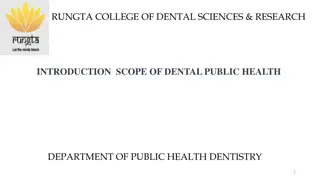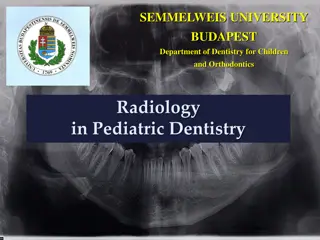Understanding Preventive Adhesive Restoration in Dentistry
Preventive adhesive restoration, also known as PAR, is a dental procedure that utilizes adhesive materials including preventive resin. It involves techniques like visual inspection, translumination, laser fluorescence, and radiographs to diagnose caries. Early intervention focuses on balancing the oral environment through bacterial testing, antimicrobial treatments, plaque removal, and remineralization. Materials such as Glass Ionomer Cement and Resin are used for restorations. The process involves bonding with the tooth structure, conditioning for improved adhesion, and addressing the advantages and disadvantages of the materials used.
Download Presentation

Please find below an Image/Link to download the presentation.
The content on the website is provided AS IS for your information and personal use only. It may not be sold, licensed, or shared on other websites without obtaining consent from the author. Download presentation by click this link. If you encounter any issues during the download, it is possible that the publisher has removed the file from their server.
E N D
Presentation Transcript
PREVENTIVE ADHESIVE RESTORATION PAR Drg. Alfini Octavia, Sp.KGA
Restorasi PAR (Preventive Adhesive Resin): Restorasi yang menggunakan bahan-bahan adhesive , termasuk didalamnya Preventive Resin Restoration PENGERTIAN
1. Pemeriksaan Visual 2.Translumination 3.Laser fluorosence 4.Radiograph TEKNIK MENDIAGNOSA KARIES
INTERVESI AWAL: Menyeimbangkan lingkungan rongga mulut : bacterial test, antimicrobial (chlorhexidine, iodine, xylitol),saliva, diet intervention Pembersihan plaque : brushing, flossing Remineralisasi: fluoride dentrificis, profesional fluoride aplication, Casein phosphopeptide-amorphous calcium phosphate (CCP- ACP) Fluoridated filling material : Glass Ionomer Cement, Resin based sealant PREVENTION FOR CARIES
1. Glass Ionomer cement 2. Resin BAHAN-BAHAN PAR
Kemampuan berikatan dengan struktur gigi secara kimia Ikatan kimia kombinasi dari struktur Ca /Strontium phosphate/polyalkenoic acid yang ada dipermukaan emaol/dentin dan permukaan bahan yang telah setting Ikatan dengan komponen organik ikatan hidrogen dengan grup karboksil pada poliacid dengan molekul kolagen pada dentin Melepaskan fluoride RESTORASI ADHESIVE DENGAN GLASS IONOMER CEMENT (GIC)
Conditioning: meningkatkan dasa adhesi gigi Bahan conditionong : citric acid,hidrogen periksid,10% poliakrilic acid Tujuannya menghilangkan smear layer Mekanisme: Menurunkan energi dipermukaan gigi Meningkatkan kelembaban di permukaan gigi Meningkatkan adhesi dari semen ke permukaan gigi DENGAN STRUKTUR GIGI
Kelebihan: Anti kariogenik Kelemahan: 1. Translusen Water in dan water out 2. 1. Biokompatibel Compressive strength rendah 3. 2. Melekat secara kimia dengan struktur gigi Resistensi terhadap abrasi rendah 4. 3. Estetil lebih rendah daripada komposit/resin 4. Sifat fisik yang stabil 5. Mudah dimanipulasi 6. KELEBIHAN DAN KELEMAHAN GIC
Secondary caries is responsible for greater than 50% of all restorations that are replaced (Mjor, 1997). Considerable fluoride release occurs during the glass ionomer cement setting reaction and continues at very low levels for years (Arends et al., 1995). The released fluoride is readily up- taken by the cavosurface tooth margins of the restorative material (Hicks et al., 2003). Resistance to secondary caries at the cavosurface margins and adjacent smooth surfaces to the glass ionomer cement restorative material has been demonstrated (Donly et al., 1999a, b). Fluoride at the restoration surface and rerelease the fluoride, the restorative material acting as a fluoride reservoir. Advantage of using glass ionomer cement restorations in children who are of moderate caries risk for the prevention of secondary caries.
PRR adalah suatu alternatif prosedur untuk merestorasi gigi tetap muda yang membutuhkan preparasi minimal untuk membuang karies di oklusal maupun di fissure yang berbatasan PREVENTIVE RESIN RESTORATION (SEALED COMPOSITE RESIN RESTORATION)
Henderson and Setcos described the sequence of the preventive resin restoration that is particularly applicable for young patients with recently erupted teeth and minimally carious pits. PREVENTIVE RESIN RESTORATION (SEALED COMPOSITE RESIN RESTORATION)
Permukaan oklusal sering memiliki karies kecil. Untuk mengatasi keausan bahan tambal karena gaya kunyah yang besar, peletakan bahan tambal biasanya lebih luas dari kariesnya.
TYPES OF PRR Based on the extent and depth of the carious lesions: a) Type A - Suspicious pits and fissures where caries removal is limited to enamel. b) Type B - Incipient lesion in dentin that is small and confined c) Type C - Characterized by the need for greater exploratory preparation in dentin
1.TYPE A RESTORATION. PLACEMENT TECHNIQUE TYPE A RESTORATION 1)CLEAN THE SURFACE 2)ISOLATION 3)REMOVE DECALCIFIED PITS AND FISSURE 4)PLACE ACID ETCHED GEL 20 TO 60 SEC 5)WASH AND DRY 6)APPLY THE SEALANT 7)POLYMERISE WITH VISIBLE LIGHT 20 SEC 8)ADJUST THE OCCLUSION, IF NEEDED
TYPE B RESTORATION PLACEMENT TECHNIQUE 1. Removal caries with a high speed no.330 bur, followed by a slow speed no.1/2 Round bur. 2. After caries removal Ca(OH)2 liner is placed . Acid etching Acid etching gel is applied over the entire occlusal surface for 20 to 60 sec , then washed 20 Sec and dried 10 sec. 3. Bonding agent application The walls of the preparation are coated with bonding agent which act as an intermediate Resin layer. 4. Composite resin application Filled composite resin is injected into the preparation and placed. 5. Resin condensed and smoothened by plastic or Teflon instrument. The composite resin is condensed and smoothed with a plastic or teflon Instrument. 6. Sealant application. Filled sealant material is Applied over the entire Occlusal surface. 7. Polymerization All layers are simultaneously Polymerized with visible light Produced by the Polymerization unit. 8. Occlusal adjustment The occlusion is adjusted, Where required, with finishing burs.
TYPE C RESTORATION. PLACEMENT TECHNIQUE 1.Repeat all steps listed for type B 2.Type C is larger and deeper add additional polymerization time (30 sec). 3. In most cases local anesthesia will also be required.
EVIDENCE: Walker and associates :preventive resin restorations placed in patients 6 to 18 years of age and observed for up to 6.5 years.Of the 5185 restorations, 83% did not require further intervention. Those requiring intervention included 37% that needed sealant alone and 21% that required treatment because of the development of an interproximal lesion. Houpt and associates :complete retention of 54% of their preventive resin resto- rations, partial loss of sealant in 25%, and complete loss of sealant in 20% after 9 years.Caries occurred in 25% of the teeth that had sealant loss, and 88% of the restored surfaces remained caries-free 9 years after treatment.
Loss of the restoration and subsequent replacement proves to be less invasive than that for conventional restoration like amalgam. PRECAUTIONS Early loss of PRR similar to pit and fissure sealants due to insufficient etching so, it is very important to maintain excellent isolation from moisture contaion ADVANTAGES Minimal cavity preparation is required thus prevents unnecessary removal of healthy tooth structure for retention. Seals caries halting the destruction of tooth. Eg: teeth with pit and fissure CONCLUSION
